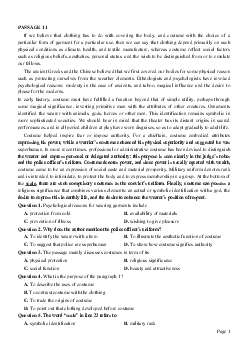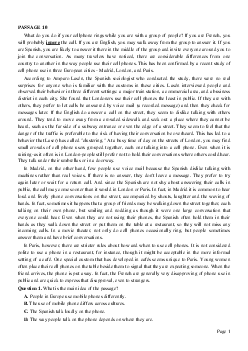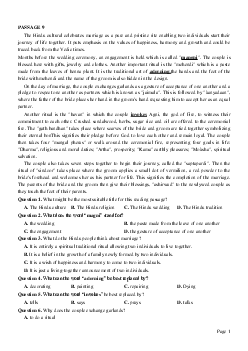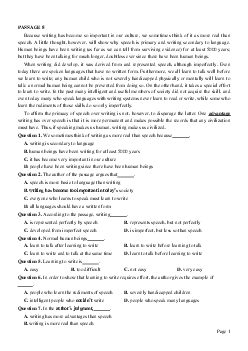


Preview text:
PASSAGE 19 Bringing up children
Where one stage of child development has been left out, or not sufficiently experienced, the child
may have to go back and capture the experience of it. A good home makes this possible - for example, by
providing the opportunity for the child to play with a clock work car or toy railway train up to any age if
he still needs to do so. This principle, in fad, underlies all psychological treatment of children in
difficulties with their development, and is the basic of work in child clinics.
The beginnings of discipline are in the nursery. Even the youngest baby is taught by gradual stages
to wait for food, to sleep and wake at regular intervals and so on. If the child feels the world around him
is a warm and friendly one, he slowly accepts Its rhythm and accustoms himself to conforming to Its
demands. Learning to wait for things, particularly for food, is a very important element in upbringing, and
is achieved successfully only if too great demands are not made before the child can understand them.
Every parent watches eagerly the child's acquisition of each new skill: the first spoken words, the first
independent steps, or the beginning of reading and writing. It is often tempting to hurry the child beyond
his natural learning rate, but this can set up dangerous feelings off failure and states of anxiety in the
child. This might happen at any stage. A baby might be forced to use a toilet too early, a young child
might be encouraged to learn to read before he knows the meaning of the words he reads. On the other
hand, though, if a child is left alone too much, or without any learning opportunities, he loses his natural
zest for life and his desire to find out new things for himself.
Learning together is a fruitful source of relationship between children and parents. By playing
together, parents learn more about their children and children learn more from their parents. Toys and
games which both parents and children can share are an important means of achieving this co-operation.
Building-block toys, jigsaw puzzles and crosswords are good examples.
Parents vary greatly in their degree of strictness or indulgence towards their children. Some may be
especially strict in money matters; others are severe over times of coming home at night, punctuality for
meals or personal cleanliness. In general, the controls imposed represent the needs of the parents and the
values of the community as much as the child's own happiness and well-being.
With regard to the development of moral standards in the growing child, consistency is very
important in parental teaching. To forbid a thing one day and excuse it the next is no foundation for
morality. Also, parents should realize that •example is better than precept". If they are hypocritical and do
not practise what they preach, their children may grow confused and emotionally insecure when they
grow old enough to think for themselves, and realize they have been, to some extent, deceived. A sudden
awareness of a marked difference between their parents' ethics and their morals can be a dangerous disillusion.
Question 1. The principle underlying all treatment of developmental difficulties in children ._.
A. is in the provision of clockwork toys and trains
B. is to send them to clinics
C. is to capture them before they are sufficiently experienced
D. offers recapture of earlier experiences
Question 2. The encouragement of children to achieve new skills .
A. should be focused on only at school
B. can never be taken too far Page 1
C. will always assist their development
D. should be balanced and moderate
Question 3. Parental controls and discipline .
A. serve a dual purpose
B. are designed to promote the child's happiness
C. reflect only the values or the community
D. should be avoided as far as possible
Question 4. The practice of the rule "Example is better than precept" .
A. only works when the children grow old enough to think for themselves
B. would help avoid the necessity for ethics and morals
C. will free a child from disillusion when he grows up
D. is too difficult for all parents to exercise
Question 5. In the 1 paragraph, the author lays some emphasis on the role of the in helping the child in trouble. A. psychiatrists B. community C. family D. nursery
Question 6. The phrase 'conforming to' in the 2nd paragraph means . A. adapting B. accepting C. agreeing with D. following
Question 7. The word 'imposed' in the 4th paragraph is closest in meaning to . A. excepted B. introduced C. made D. constrained
Question 8. Hypocrisy on the part of the parents may .
A. result in their children's wrong behaviour
B. disqualify their teachings altogether
C. make their children lose faith in them
D. impair their children's mind ĐÁP ÁN 1-D 2-D 3-A 4-C 5-C 6- 7-D 8-B
LỜI GIẢI CHI TIẾT Question 1: D
Nguyên tắc cơ bản của tất cả các điều trị khó khăn phát triển ở trẻ em ._.
A. là trong việc cung cấp đồ chơi đồng hồ và xe lửa
B. là gửi chúng đến phòng khám
C. là bắt chúng trước khi chúng có đủ kinh nghiệm
D. cung cấp sự chiếm lại các kinh nghiệm trước đó Question 2: D
Sự khuyến khích của trẻ em để đạt được các kỹ năng mới .
A. chỉ nên tập trung ở trường
B. không bao giờ có thể được đưa quá xa
C. sẽ luôn hỗ trợ sự phát triển của họ
D. nên cân đối và vừa phải Question 3: A
Kiểm soát và kỷ luật của cha mẹ . Page 2
A. phục vụ một mục đích kép
B. được thiết kế để thúc đẩy hạnh phúc của trẻ
C. chỉ phản ánh các giá trị hoặc cộng đồng
D. nên tránh càng xa càng tốt Question 4: C
Việc thực hành quy tắc " Example is better than precept " .
A. chỉ làm việc khi những đứa trẻ đủ lớn để tự suy nghĩ
B. sẽ giúp tránh sự cần thiết cho đạo đức và đạo đức
C. sẽ giải thoát một đứa trẻ khỏi vỡ mộng khi lớn lên
D. quá khó cho tất cả các bậc cha mẹ tập thể dục Question 5: C
Trong đoạn 1, tác giả nêu một số nhấn mạnh về vai trò của
trong việc giúp đỡ trẻ gặp khó khăn. A. bác sĩ tâm thần B. cộng đồng C. gia đình D. nhà trẻ Question 6: A
Cụm từ 'conforming to' trong đoạn 2 có nghĩa là . A. thích nghi với B. chấp nhận C. đồng ý với D. sau Question 7: D
Từ imposed trong đoạn thứ 4 có nghĩa gần nhất với_ A. ngoại trừ B. giới thiệu C. thực hiện D. hạn chế Question 8: B
Đạo đức giả về phía cha mẹ có thể .
A. dẫn đến hành vi sai trái của con cái họ
C. không đủ tiêu chuẩn giáo lý của họ
B. làm cho con cái họ mất niềm tin vào chúng
D. làm suy yếu tâm trí trẻ em của họ Page 3




